Benjamin Marra is one of the most interesting artists working today. And although mainly self-published, Marra has done comics for both Vice (various strips) and Image (the excellent Jesusfreak which was co-created with writer Joe Casey).
Benjamin was cool enough to take some time to talk to us at Monkeys Fighting Robots about his career, his current comic What We Mean By Yetsreday (which he is posting daily on Instagram), his love of classic RPG art, where comics might be going in this post-pandemic world and a bunch more. So read on!
Monkeys Fighting Robots: First of all, thanks for taking the time to talk to us at Monkeys Fighting Robots. A bunch of us fans are excited!
Benjamin Marra: Cool, thanks very much for having me.
MFR ON YOUTUBE (latest video)
Help us reach 5K Subs!
MFR: Personally, the first thing I ever got of yours was Lincoln Washington Free Man which was gifted to me by a coworker when I ran an indie bookstore years ago. I still have it and it’s one of my favorite single-issue comics I own.
BM: Awesome. Yeah, those single issues of my self-published comics are pretty hard to find now
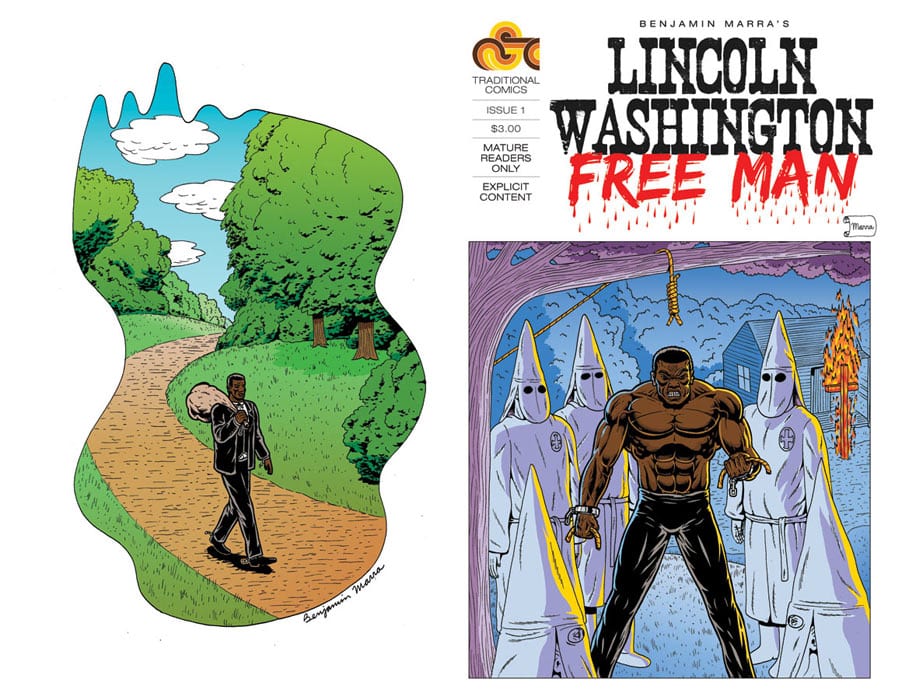
MFR: For those not familiar with your work, give us a brief history of you as a cartoonist.
BM: I’ve been doing comics in earnest since 2007 when I published the first issue of NIGHT BUSINESS, my 80s-crime, 70s-Giallo homage. I self-published a bunch of other books experimenting with different approaches to cartooning. But I’ve been drawing since I can remember. I studied illustration at Syracuse University, then got my MFA in illustration at SVA. I do a lot of illustration work in addition to making comics.
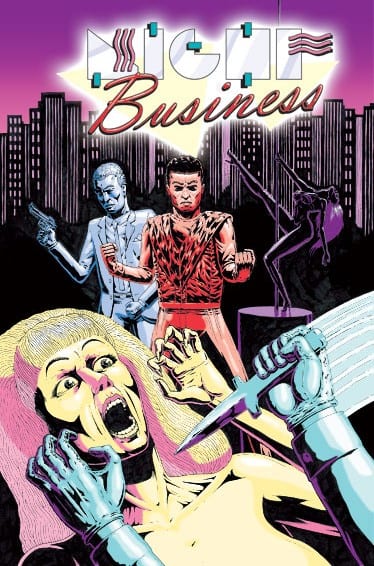
MFR: Who or what would you say were your biggest comic book influences?
BM: It’s difficult to say because my influences are constantly changing. When I first started making comics Paul Gulacy, Eric J on REX MUNDI, and Marc Laming on AMERICAN CENTURY were huge influences. Gary Panter has been a constant influence though many times not directly. Recently, Ebizu Yoshikazu has been a big influence. I’ve been thinking about Tomi Ungerer a lot (though he’s not a comic book artist per se). Mike Judge has been a big influence. Gary Larsen. Charles Schulz. I like what Matthew Thurber has been doing a lot recently.
MFR: What other media do you draw inspiration from?
BM: Fine art and illustration both inform my comic process, as far as drawing goes. Genre prose fiction—science fiction, fantasy, crime—has a big influence. Genre film, obviously, is a huge inspiration. I’d say my sources of inspiration outside comics are bigger than the number of comics that inspire me
MFR: I’ve also read you’re also an avid RPG/Dungeons and Dragons fan (the art and the game). What about it inspired you and what artistic tools do you take from it?
BM: I love early TSR D&D artwork, as well as the game itself. For me, the artwork hits the perfect note of naive intention. The artwork is trying its best to be the most sophisticated art it can be. It misses the mark entirely. It has a DIY quality and emotional quality that resonates with me. Ultimately it’s work that’s made with a lot of love and care, and that really comes through. I also love the subject matter of fantasy art. The tools I take from it, I guess, literally, is that you can make cool black-and-white drawings with cheap pens and paper.
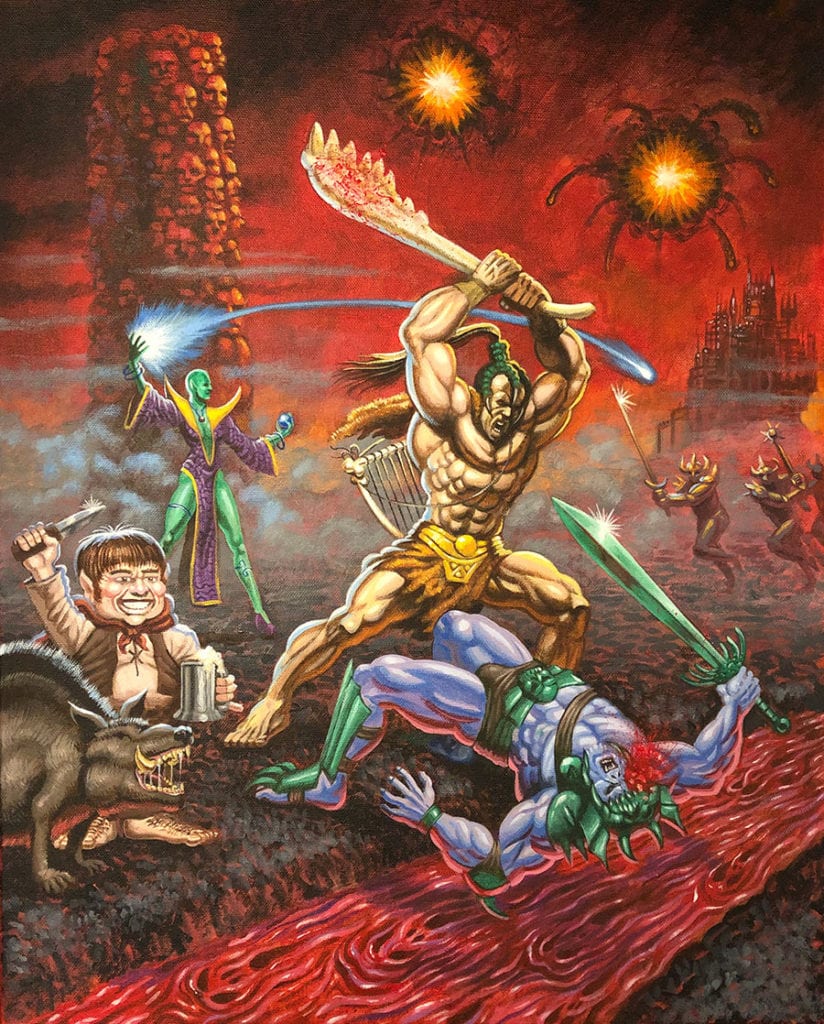
MFR: Do you have a personal favorite of your own work? One you think best represents you as an artist?
BM: Not really. I’m a pretty savage critic of my own work. It is what it is. I don’t really look back on it with much affection. I look forward to what I’m going to create next. I couldn’t pick one work to represent me, because I feel all of them fall short of what I can do. That kind of propels me forward to make the next thing, which I’m sure will also disappoint me as we
MFR: Okay, so I wanted to talk to you about What We Mean By Yesterday, your new comic you are putting out through Instagram daily. Can you tell our readers a bit about what the comic is about? The who and the what of the story. From what I understand a version of this appeared on Vice before.
BM: The comic is about characters in a town all linked by a high school. The first section of the story follows the afternoon and evening of one of the teachers in the school, Mr. Barnes. He has a lot of bad things happen to him and gets mistreated by people. I won’t know the true meaning of the story until it’s finished and it may never be finished.
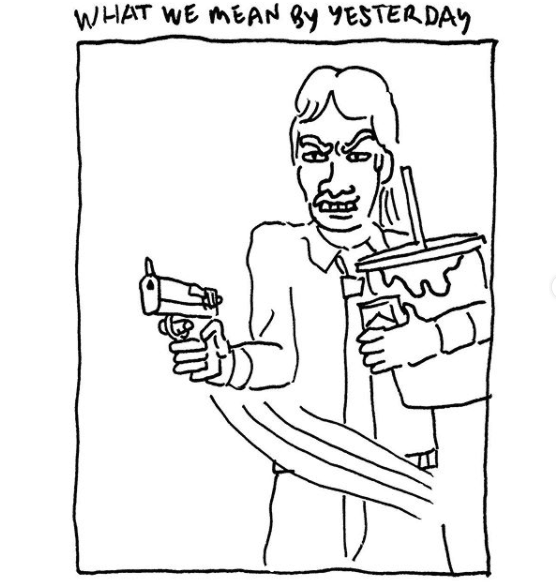
MFR: How did you come up with the idea to re-do via Instagram? Was it the idea that led to the format or the format that led to the idea?
BM: My friend Michael DeForge did a daily comic last year and I thought it worked really well. I did a couple of weekly comics for adultswim.com and my interest in comic strips returned. I hadn’t seriously looked at comic strips since I was a lot younger. Doing a daily strip is an interesting challenge. I wanted to see if I could do it for a year. I also wanted to do something personal but needed a framework or system to ensure I would do the work. The daily strip is not a huge amount of work per day, but if you do one a day for a year, it really adds up to a good volume of pages. I also wanted to work on something that would allow me to experiment with simpler, boiled-down, nothing-but-the-essentials, heta-uma style. I guess it was the format that led to the idea because I probably wouldn’t be doing the comic if it weren’t for Instagram.
MFR: What’s your process for What We Mean By Yesterday’ like?
BM: I work as fast as possible. I do the strips in batches of 14 to 20 in advance. My pencils are basically my writing. So I pencil out the pages, get into a flow, then I go back and ink everything, scan it in, and set it up to be posted. I have a big master outline I worked on for several weeks before I started. That’s kind of my guide for the story.
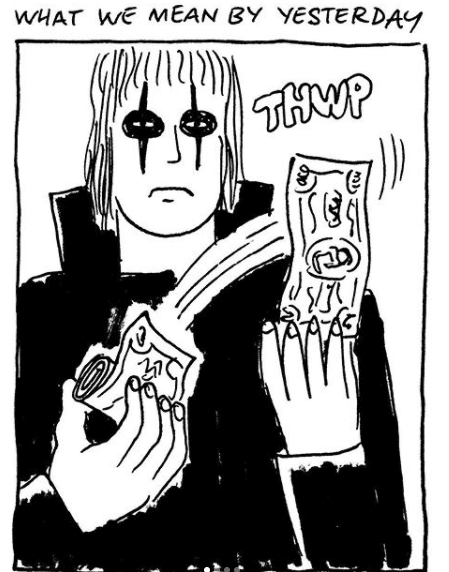
MFR: Do you plan on ever collecting this version outside of Instagram?
BM: Sure. If a publisher is willing to publish it. When it’s ready I’ll probably submit it to Fantagraphics. If they don’t want to do it, maybe another publisher will. And if no one, then I’ll probably self publish it somehow through a print-on-demand service.
MFR: You’ve also become a frequent part of the popular (and favorite around here at MFR) Cartoonist Kayfabe podcast. What led to that?
BM: I’ve known Jim and Ed (and Tom Scioli) since I started making comics. We’d hang and room together at comic conventions, like SPX and Heroes Con. So we’ve been friends a long time and bonded over comics and making comics. Our tastes are very much aligned. There are things I can talk about with them that I can’t talk about with anyone else.
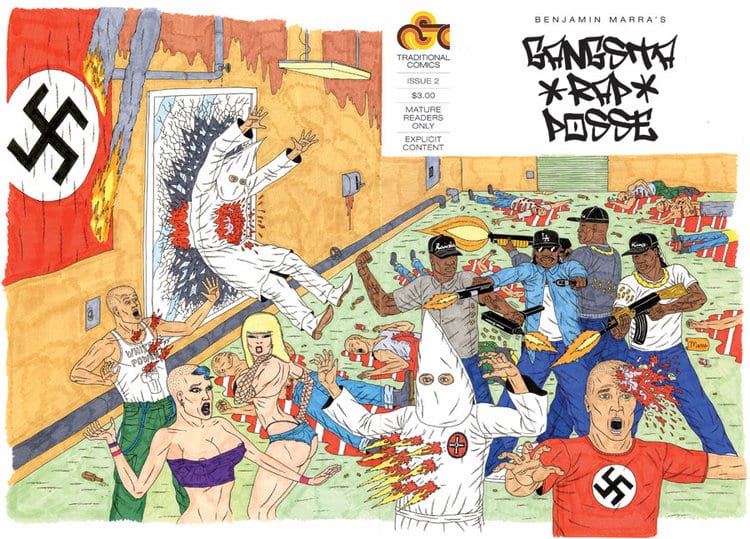
MFR: There also seems to be a small resurgence of people diving back into back issues, dollar bins and more indie and self-published work. As a member of that community why do you think it’s gaining steam again?
BM: It’s because mainstream comics are terrible. The Big Two publish nothing but dreck these days. It’s impossible to read any of that stuff. So for quality comic book entertainment fans are mining the past when comics were actually fun to read. All that stuff is very accessible and cheap. It’s no wonder they’d pay 50 cents for a comic that’s 100 times more entertaining than a new one on the racks that costs $5.99.
MFR: So just to talk about the elephant in the room real, how are you dealing with the current national crisis?
BM: Like everyone else, hopefully. My wife and I are holed up in our apartment. We don’t go outside. We have our groceries delivered to us for the most part. We’re expecting a baby in the next couple of weeks so we are serious about not being exposed to the virus. It angers me when we must go outside (for trips to the hospital for prenatal appointments) and people don’t adhere to the social distancing guidelines. But like a lot of cartoonists, I’m built for this kind of life. I prefer to stay inside and work on my comics, drawings, and play RPGs
MFR: As a cartoonist, you must have some advice about staying at home so much? Care to share some?
BM: Have a routine. Routines and having a daily schedule are absolutely critical. Find projects to work on that are enjoyable. I’m not talking about home-improvement projects or things that feel like work. Write, draw, paint, read, do puzzles, play games. Do it enough that you develop a routine. Don’t just watch TV and search for more TV shows and movies to watch. You don’t have to be productive, just find something you can escape into.
MFR: Where do you see comics at the other end of all this?
BM: It’s tough to imagine the same amount of retail outlets surviving the pandemic and impending economic recession (or maybe depression). Only half of the comic shops in North America survived the boom and bust of the early 90s. That number will be whittled down even further. I wonder if DC Comics will continue to exist or if they’ll finally license out their properties to other publishing houses like Marvel or IDW. When the brick-and-mortar retail stores become irrelevant sites like Comixology may be the best option for new mainstream comics. The direct market will probably be most affected because it is completely dependent on the whims of Diamond Distribution, which has decided not to operate for who knows how long. I think independent publishers will, by and large, find a way to survive, because that’s what they’re built to do. Comic creators may turn to other channels to get their work to readers. There will probably be a jump in webcomics. Creators may turn to print-on-demand services or sites like Gumroad. Comics will continue to be made, but the non-traditional delivery systems, like digital, will flourish.
MFR: Are there any current comics or creators that excite you?
BM: Walter Scott, Karissa Sakmoto, Matthew Thurber, Leon Sadler, Michael DeForge, Michel Fiffe, Lale Westvind, Jon Chandler, Jillian Tamaki, Charles Forsman, Michael Comeau, Conor Willumsen to name a few.
MFR: Are you currently working on anything you want to mention?
BM: I have a few projects that are pending but can’t really talk about. Some RPG work that I’m looking forward to. And, of course, WHAT WE MEAN BY YESTERDAY.
MFR: And finally where is the best place for people to reach you and reach your work?
BM: Instagram is best: @benjamin_marra. Or my website works: benjaminmarra.com
All images courtesy of benjaminmarra.com

